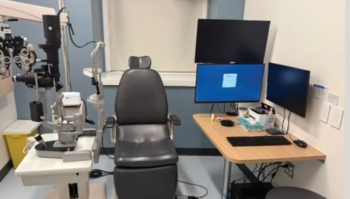
Success at one year with miniature glaucoma shunt
A proprietary miniature glaucoma device (Ex-PRESS; Optonol Ltd.) implanted under a partial-thickness scleral flap achieves significant decreases in intraocular pressure (IOP) in patients with glaucoma, according to Peter A. Netland, MD, PhD, reporting at the 2007 meeting of the Association for Research in Vision and Ophthalmology.
Key Points
Aproprietary miniature glaucoma device (Ex-PRESS; Optonol Ltd.) implanted under a partial-thickness scleral flap achieves significant decreases in intraocular pressure (IOP) in patients with glaucoma, according to Peter A. Netland, MD, PhD, reporting at the 2007 meeting of the Association for Research in Vision and Ophthalmology. The success rate with the valve was 89% six months after implantation and remained high at the one-year follow-up examination.
In a retrospective, non-comparative case series of patients, Dr Netland and colleagues implanted the device under a scleral flap in patients with glaucoma who had elevated IOP that was refractory to maximal medical therapy. The investigators defined successful procedures as those in which the postoperative IOP was between 5 and 21 mmHg with or without additional medication and without the need for further glaucoma surgery. The valve was implanted in 300 consecutive eyes and the mean follow-up period was 17 months (range: three to 36 months).
Reliance on medications significantly reduced
"The number of glaucoma medications taken by patients significantly decreased during the postoperative period. The success rate was 89% at six months, 87.3% at nine months, and 84.9% at one year postoperatively."
No conjunctival erosion developed over the device in any patients and in five patients (1.7%), the lumen of the implant became obstructed; that occurrence was treated successfully with the Nd:YAG laser.
"The . . . miniature glaucoma device implanted under a scleral flap was safe and effective. Blockage of the lumen of the device in a small proportion of patients was effectively treated," Dr Netland said.
The shunt versus trabeculectomy
In a previous, retrospective comparative study that included 100 eyes, Dr Netland, Dr Peter Maris Jr. and Dr Kyoko Ishida compared the outcomes after implantation of the valve with those achieved with standard trabeculectomy. Fifty eyes of 49 patients received the device, and 50 eyes of 47 patients underwent a standard trabeculectomy.1
The average follow-up was 10.8 months (range, 3.5–18 months). The investigators reported that, during the early postoperative period, the IOP values in the eyes in which the valve had been implanted were significantly higher than in the eyes that received the standard of care. By the three-month postoperative evaluation, the degree by which IOP decreased was similar in both treatment groups, and the number of anti-glaucomatous medications did not differ between the groups.
The investigators reported that "the . . . implant under a scleral flap had similar IOP-lowering efficacy with a lower rate of early hypotony compared with trabeculectomy."
Unlike with trabeculectomy, implantation of the device does not require a sclerostomy and peripheral iridectomy. This fact may mean minimization of the variability of results in different patients. It is possible that inflammation during the early postoperative period may be lessened by implantation of the valve.
Reference
1. P.A. Netland, et al. J. Glaucom. 2006;16:14-19.
Newsletter
Get the essential updates shaping the future of pharma manufacturing and compliance—subscribe today to Pharmaceutical Technology and never miss a breakthrough.













































